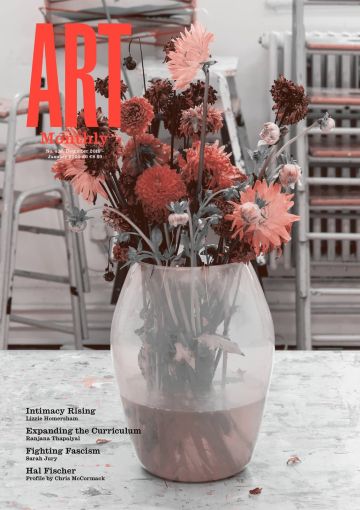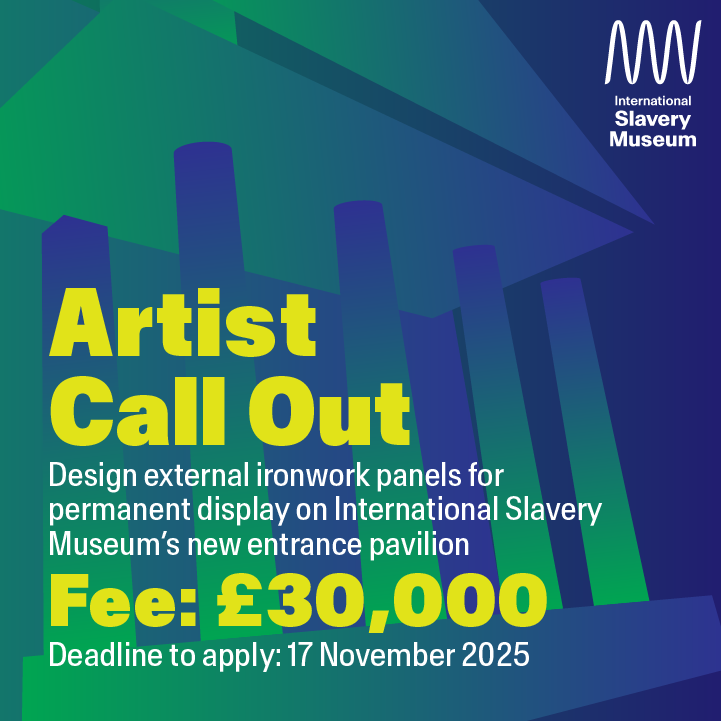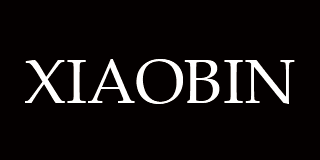Feature
Fighting Fascism
Sarah Jury argues that art can make a difference

The 5th World Festival of Youth and Students, Warsaw, 1955
Art, argues Sarah Jury, is one of the few remaining spaces where cultural activism can make a difference, but not enough is being done by our institutions and public spaces to challenge the drift to the right.
#MeToo has made again ArtReview’s ‘Power 100’. I mention this because cultural institutions are confusing partners for political activism. Regardless, political art largely informs an increasing number of group exhibitions, biennales and summits. Transnationally, the cultural sector is seemingly unified in resisting the encroachment of fascist politics, but its efforts sometimes seem disconnected from true political change.
As we know all too well, the UK government’s decade-long austerity programme contributed to the cultural sector and higher-education institutions becoming increasingly reliant on private-sector income. This reliance introduces stakeholder conflicts because of mixed political alliances. In some countries, controls on freedom of speech mean that certain levels of complicity are needed to safeguard those involved in arts programming, but in those environments art provides an even more valuable voice of critique and dissent.
These shifting institutional interests are exemplified by moments such as in the exhibition ‘Hope to Nope: Graphics and Politics 2008–18’ held in mid 2018 at London’s Design Museum. The exhibition attempted to maintain an apolitical standpoint while exhibiting activist-printed material and charging the public to see it. Artists and designers withdrew their work after the museum hosted a private event for an arms manufacturer during the exhibition’s run (Artnotes AM419). The statement released by the museum’s co-directors, Alice Black and Deyan Sudjic, included the term ‘professional activist’ as a derogatory reference to those who publicly complained about the museum’s actions. The statement highlighted the way that the institution’s directors had underestimated the active politics that interlaced the exhibited work, the pair seemingly expecting that the artworks could be separated from real life to produce a disinterested aesthetic experience.
To further situate the ethical position of an organisation like the Design Museum, it is a common misconception that registered charities cannot fund or otherwise support political campaigns. In fact, the only limitation is that charities must avoid being party political. This is, perhaps, why it is the broader political terms, such as ‘feminism’, ‘democracy’ and ‘anti-fascism’, that filter into public programming.
This broad terminology helpfully connects interrelated ideologies, making it quicker to discuss politics on an ideological and societal level. Semantically, using the same terms repeatedly (in the media, in discussion, in text) draws attention to and leads towards the building of a movement. The downside is a loss of awareness of the details concerning what lies behind campaigns: what happened, who caused it, what are the interrelated ideologies within, and who is affected by them. In the case of fascism, although widely acknowledged as heinous, I am sometimes asked what this term actually means in relation to contemporary politics – who are these ‘fascists’ and what are they doing? I do not want a lack of understanding to be a barrier to recruiting allies to anti-fascism; this means being clear while keeping the complexity of the term.
Fascism itself is a self-contradicting ideology, often enacted by misogynistic power-hungry individuals who fear difference and tolerance and who command hierarchical groups formed to protect certain beliefs against ideological attack. This ‘attack’ is often just a person living their life. Fascists employ a culture of violence and social oppression to enact prejudice based on race, faith, class, nationality, gender, mental and physical ability, sexuality – and many other facets of humanity. Anti-fascism is a reactionary ideology which rose up to disassemble fascist mentalities. Anti-fascist movements include those which seek equality and freedom of movement, and which counter systems built on discrimination at all levels. By its nature, this usually positions anti-fascist movements as being at odds with capitalism. It is easier to consider fascism and anti-fascism as dualistic, but it takes just a moment to think of the contradictions; for instance, some historical (and unfortunately still existing) feminist factions campaign for equal rights for women yet discriminate against those of trans gender identity, an issue the Wellcome Collection faced last year while hosting ‘Daylighting’. This four-day event programme was initially marketed using the arguably ostracising term ‘womxn’, which acted as a red flag to trans-exclusionary radical feminists (TERFs) who trolled public media around the event and placed discriminatory campaign materials within the building.
During the past two years, the European Cultural Foundation has made available funds explicitly to support ‘cultural activists ... who are fighting for their rights as citizens, for their right to public space and personal freedoms, and for their right to creative expression’. Speaking to director André Wilkens during the mini-summit positioned as the London stage of ‘What Can Culture Do?’ – a ‘multi-Europe’ strategic development tour – it is evident that he senses an urgency to counter a European shift towards right- wing politics and that he believes the cultural space is where that battle can be fought.
In 2019, most major art-publishing houses released books on activism and social action in public art spaces or education. They include What about Activism? and The Art of Direct Action (Sternberg Press), Protest: The Aesthetics of Resistance (Lars Muller Publishers), Art as Social Action (Allworth Press), Curatorial Activism (Thames & Hudson). Each title edits together essays by noteworthy educators, curators and museum directors who explain how the arts can and have been a mouthpiece for challenging the status quo. Some contributors to these books acknowledge the contradictions in their work. Fewer speak of internal politics and policy. Many of the institutions represented still outsource staff, pay less than the appropriate Living Wage, do not have diversity representation among staff and board, and have other policies that inhibit the achievement of a true democratic society. The UK may be less familiar with the experience of state-controlled cultural institutions, yet it is in part due to a similar frustrated disillusionment with institutional politics that individuals take to counterculture and independent platforms to enact radical or activist cultural practice. The significance of independent cultural space (physical or other) is incisively acknowledged in The Art of Civil Action, Political Space and Civil Action, 2017, published by Valiz.
I was recently at ‘Never Again’, an anti-fascist summit held at the Museum of Modern Art in Warsaw. This event addressed crucial issues in social politics in Eastern Europe and beyond. Thanks to the work of Kuba Szreder, Sebastian Cichocki and Marsha Bradfield and their colleagues, time and space were made available for those in attendance to put into motion plans to enact change. This summit was my first interaction with the event partner l’Internationale, a fairly introspective confederation of seven art institutions, which proposes ‘a space for art within a non-hierarchical and decentralised internationalism, based on the values of difference and horizontal exchange amongst a constellation of cultural agents, locally rooted and globally connected’. In his second presentation during the summit, confederation representative Charles Esche called out his own white male privilege and the long-established structural bias that contributed to his presence on that stage. This left me wondering, why merely call out an issue if you have the power to do something about it? Is it enough that Esche raised awareness of the issue?
To contextualise: many other speakers at this summit raised important social issues by sharing their work and connected activist movements. This recruited allies to social causes: people who will spread the word further, who may enact changes themselves or come up with solutions to achieve change on a greater scale. In considering how academics might contribute to the anti-fascist cause beyond generating material for further academic discourse, resources were shared to readdress the archival canon in order to include anti-fascist work previously suppressed from archives (https://rokantyfaszystowski.org/en/atlas), ideas were raised that reconsider border politics (by Quinsy Gario, for example) and new tactics were floated to raise consciousness and the importance of moments of collective joy (such as from Plan C, Nadia Idle and Keir Milburn).
The outcomes from this summit are still to be seen, but already a new anti-fascist syllabus is being written, a tool for building an international political arts network is being developed and, while not directly attributed to the summit, an international selection of voices was rallied to put their names behind a letter protesting against the Polish Ministry of Culture’s appointment of Piotr Bernatowicz to the position of director of Ujazdowski Castle (CCA). Beyond the already concerning dictatorial fashion in which this recruitment was made, Piotr Bernatowicz is accused of platforming misogynistic artworks, such as in the exhibition ‘Strategies of Rebellion’ at Arsenal Municipal Gallery in 2015, and anti-Semitic artworks, as he did in ‘Arsenal of Culture’, a 2017 radio broadcast for Radio Poznań. His appointment was followed by the publication of his proposed programme, which states his intentions to turn the CCA into ‘a Center for Reflection on Art, an art that has been neglected by the current marxist and neomarxist discourse’. The style of recruitment at the Ujazdowski Castle is not used in the UK – yet – but it has an impact on the cultural environment within which many of us work.
It feels significant that this appointment happened during the polish Anti-Fascist Year, a year in which hundreds of cultural projects were self-organised to counteract a rising fascist political threat, but it doesn’t feel like defeat. In addition to ‘Never Again’, the past year saw the dedication of independent and state-funded annual summits – such as Switzerland’s ‘Verbier Art Summit’, Sheffield’s ‘Social Art Summit’ and Bristol’s ‘Radmin’ – struggle to work though contradictory methodologies, confused stakeholders and economic elitism. The most effective way for artists, educators, curators, writers, activists, museums and publications to fight fascism isn’t yet clear, but it is widely discussed. I bounce from being annoyed that there is so much discourse that it has become an industry in its own right, to being relieved that so many people are trying to do something.
The differing professional capacities of those present at these summits indicates an interest in change-making that extends across the field, but also highlights the educational facility that art practitioners are expected to enact. Instructive is the view of another museum director, Defne Ayas: her contribution to the 2019 Sternberg Press publication What about Activism? pointed out that ‘artists [have] abilities to imagine the world otherwise and to system-break and channel the transformative energies of the world ... Only when we acknowledge our responsibility to address the issues raised by artists and activists can we be trusted collaborators. We have to figure out the extent to which we have been the enemy; how we have willingly or unwillingly perpetuated aspects of the economic and social conditions in our contemporary lived experiences at the cost of others; how we have affirmed and thrived on foundations of political liberalism that have gone off the rails ... Embrace the volatile energies of politics, finance and, of course, art in order to allow them to change our spaces and our programmes – and also who we are.’
While Ayas’s statement embraces change, it positions practitioners in the arts as being responsible for demanding change and, in so doing, charging already precarious artists with the task of challenging the way their commissioners and funders do things. To return to the comment made by the director of the Van Abbemuseum at ‘Never Again’, I wonder why Esche did not enact the change that he asked to see by nominating someone reaping fewer benefits from structural privilege to take to the stage in his place. If you have the power, yet are not willing to change something by your own actions, is it still useful to use your platform to publicly call it out? Are we still living with the reality that the sacrifice required in order to gain access to a platform is to be complicit in the structural bias?
It is not my intention to downplay the work of people and cultural platforms who are putting resources behind challenging fascist politics. I suggest that a powerful way to extend this work would be to self-educate and internally enact changes correspondingly. Issues such as who is not in the room, who gets to speak and who affects decision-making remain restricted by structural bias. Not enough is done to challenge this even though there are tools to assist with this. Teresa Cisneros’s Document 0, 2018, gives a critical insight into the failures and misinterpretations of Arts Council England’s ‘Creative Case for Diversity’ and ‘Cultural Democracy in Practice’. Many of the summits mentioned above require paid entry, international travel is often involved, and some are invite-only or reliant on existing and biased networks. There are strategies to counter this, but they are not widely used. Too few of the people – or institutions – who argue for democracy in their public work are challenging internal systems and structures.
Reflecting on the fertile ground of political art movements, Rasheed Araeen wrote, in his 2010 Third Text essay ‘Art beyond Art, Ecoaesthetics: A Manifesto for the 21st Century’, that ‘ideas can be and are turned into institutionally manageable objects, thus contained in their temporalities, but ideas as knowledge can never be trapped as the property of an individual or the institution. They can always salvage themselves, give themselves a new context and move forward within the dynamic of new time and space. They can indeed perform a radically new transformative function in dealing with today’s situation. But for this art must go beyond what prevails as art and integrate itself with the collective struggle of life today to recover its true social function and become a radical force of the 21st century.’ I found this quotation thanks to Kuba Szreder, who mentions it in his recent interview ‘Art and Theory in an Anti-Fascist Year’, which is available on Third Text Online .
These platforms for political organising and discussion in the cultural sector are undoubtedly necessary, and those who are dedicated to supporting the development of political democracy internally and in public programmes are productive, even if there is a way still to go. But there is room for different approaches. In Emergent Strategy, published by AK Press, Adrienne Maree Brown shares a metaphor offered by Jenny Lee, founder of Allied Media Projects, about organisers being like earthworms in an ecosystem, ‘processing and aerating soil, making fertile ground out of the nutrients … to nurture the next cycle of life’. We need to keep churning.
Sarah Jury is a creative practitioner based in London.
First published in Art Monthly 432: Dec-Jan 19-20.










